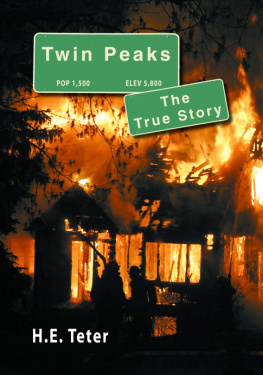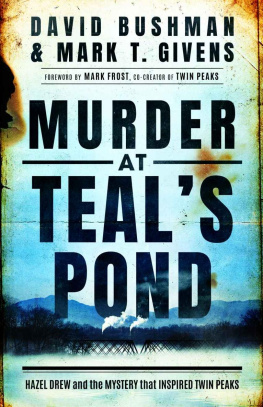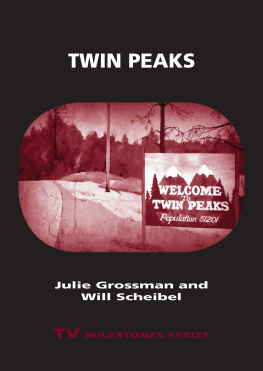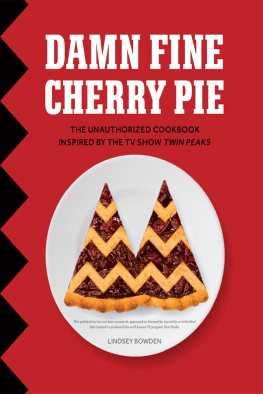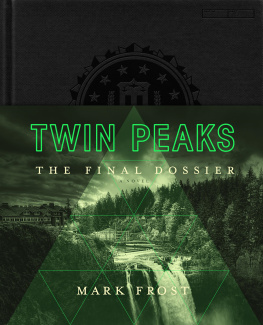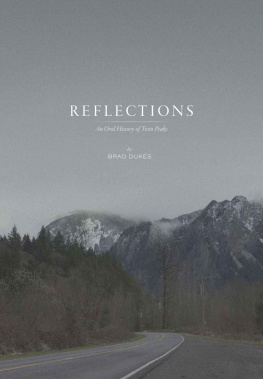
Approaching Twin Peaks
Critical Essays on the Original Series
Edited by ERIC HOFFMAN and DOMINICK GRACE

McFarland & Company, Inc., Publishers
Jefferson, North Carolina
LIBRARY OF CONGRESS CATALOGUING DATA ARE AVAILABLE
BRITISH LIBRARY CATALOGUING DATA ARE AVAILABLE
e-ISBN: 978-1-4766-3005-2
2017 Eric Hoffman and Dominick Grace. All rights reserved
No part of this book may be reproduced or transmitted in any form or by any means, electronic or mechanical, including photocopying or recording, or by any information storage and retrieval system, without permission in writing from the publisher.
Front cover images 2017 LaurieSH/iStock
McFarland & Company, Inc., Publishers
Box 611, Jefferson, North Carolina 28640
www.mcfarlandpub.com
Acknowledgments
We wish to express our thanks to our contributors, for their patience through this long process, and for their dedication to this project. We also wish to thank Rebecca Heath for her editorial assistance.
Introduction. A place both wonderful and strange: The Legacy of Twin Peaks
It is happening again is one of many resonant lines from Twin Peaks. It derives from episode seven of season two, Lonely Souls, co-written by Mark Frost and David Lynch. It first aired on November 10, 1990, and it remains one of the most memorable and horrifying episodes of a television show ever broadcasteven measured against the standard of the far more graphic violence, sex and foul language that can be used on television today, especially on cable and premium channels. The episode finally revealedtoo late for many viewers, perhaps, though much earlier than Lynch and Frost had ever intendedthe identity of the murderer of Laura Palmer, as he kills again, this time claiming Maddy Ferguson, Lauras cousin/doppelgnger (both characters are played by the same actress, Sheryl Lee, who was originally to play Laura only and whose expanded role is just one of the many instances of how the show changed as it developed). While the murder occurs, the mysterious Giant (Carel Struycklen) appears again to FBI special agent Dale Cooper (Kyle MacLachlan)he initially appeared in Coopers room at the Great Northern Hotel in the second season premiere, shortly after Cooper was shot in the first season cliffhangertwice intoning the warning, It is happening again, following which an elderly bellhop (character actor Hank Worden), who first appeared at the Great Northern just prior to the Giants initial appearance, approaches Cooper and condoles with him, telling Cooper he is very sorry.
The murder of Maddy is rendered all the more tragic and terrifying as the audience realizes, as Cooper does not, the import of this warning. Coopers blank incomprehension testifies to the helplessness the world of rational order, as represented by law enforcement here, is in the face not merely of murder but of inconceivable forces that lie outside the normal realms of human consciousness. Why could the warning not have come earlier? Why could the Giant not have specified what it was, or where it was happening, or who was doing it? For that matter, why can the Giant himself not act to prevent it? Perhaps more than any other scene in the series, this one epitomizes its uncanny, elliptical, and enigmatic narrative agenda. Now, more than 25 years later, it is happening again again.
Twin Peaks, the brainchild of Mark Frost, best known before as one of the writers on the acclaimed and ground-breaking television police drama Hill Street Blues (198187), and film auteur David Lynch, flared gloriously and briefly across the television firmament before sputtering in its second season (though ratings declined even in the first season) and being cancelled. Much like Laura Palmer, though, who died before the series began but haunted it throughout its run and featured prominently in the film prequel Twin Peaks: Fire Walk with Me (1992), Twin Peaks has lingered in the popular consciousnessor at any rate, in that of a significant fan coterie, sufficient to make the show, according to David Bianculli, the cult TV show to end all cult TV shows (299). It premiered on ABC on April 8, 1990, and it finished a mere 14 months later, on June 10, 1991. In sum, the show consisted of a pilot film running 94 minutes (for a two-hour television slot, including commercials; the season two premiere was also an extra-length episode, 93 minutes), and 29 additional episodes (seven in season one, 22 in season two)approximately 25 hours of material, excluding commercials. For most television series, this would be a short run almost certainly guaranteeing oblivion after the end of an original run, as conventional wisdom states that at least 100 episodes are necessary for a show to survive in syndication (though there are exceptions, such as the original Star Trek series), and Twin Peaks aired well before the release of television seasons on video was a well-established marketing method.Twin Peaks did resurface on Bravo in 1993, a broadcast which included new introductions to each episode shot by Lynch and featuring the Log Lady (Catherine Coulson), but it has not been a staple of television since, in contrast to many other shows which have acquired cult status. However, it has not been assigned to the oblivion that the majority of short-run shows faced in the pre-digital era.
Initially, Twin Peaks looked likely to be a huge hit for ABC. Canny pre-broadcast hype and screenings for TV critics yielded it significant accolades. As David Hughes reports, even before Twin Peaks was broadcast, the press was championing the series as a television milestone, and when Twin Peaks went on the air, the rave reviews were plentiful (117). The pilot achieved an overall audience share of 33%in other words, a third of all those watching television between nine and eleven p.m., or around thirty-five million viewers (118), making it an initial hit not only with critics but also with a broad audience. As Michel Chion notes, the series very quickly became a worldwide phenomenon of great interest both to intellectuals and the general public (95). The show was also marketed with an impressive array of ancillary and tie-in products, some fairly conventional and generic like the book The Secret Diary of Laura Palmer, in fact penned by Lynchs daughter Jennifer, others rather more odd and specific, such as cherry pies stamped RR (the town coffee-shop and restaurant where the main characters often meet) (Chion 95). Part of the appeal of the show was Twin Peaks suturing together of elements from a wide array of genres, seemingly offering something for almost any viewer. As John Alexander argues, Twin Peaks is not just superior television drama. It succeeds because it encompasses all television: soap opera, melodrama, murder mystery, situation comedy, high-school romanceTwin Peaks is the unabridged collection of television clichs (149).
However, Twin Peaks also challenged the expectations and tolerance of 1990s television viewers, and despite the marketing and tie-in products, suggestive of a broad popular appeal (or at any rate, ABCs hopes for a broad appeal), it evidently troubled ABC as much as it excited the network. For all the push and hype, ABC clearly hedged its bets. Lynch was required to produce not only the finished pilot for a series but also a narratively-closed film version. Lynch explained to Chris Rodley that this was a strictly economic decision forced on the show by ABC: they said, You have to shoot an alternate ending. It has to have an ending for foreign markets (Lynch 163). Clearly, ABC did not see the series as marketable outside North America (a misjudgment, given that it was popular in numerous markets). ABC further hedged its bets by delaying a series order, limiting its initial order to only seven episodes (beyond the pilot)exceedingly unusual in the American market, in which, at the time, 2224 episodes usually comprised a full seasonpremiered the show in April, when most series have already finished their runs (in 2016 the summer became a standard launching season for new shows, but this was not the case in the early 1990s), and held off on ordering a second season until the first season was nearly over. Whether
Next page


